
Saudi Arabia’s Wahba Crater has achieved international recognition, after being nominated among the top 100 geological landmarks worldwide by UNESCO and the International Union of Geological Sciences (IUGS).
Saudi Geological Survey (SGS) announced the selection and nomination of the Waba Crater, also known as the Tamiya Quarry or scientifically as the Al-Mar Volcano, on Wednesday, August 28.
Pertinently, Wahba Crater is the largest and deepest volcanic crater in Saudi Arabia, located in Hurrat Khishb, about 270 km northeast of Jeddah.
Formed about 1.1 million years ago, it has a diameter of 3,000 meters and is surrounded by Al Luhayan, Umm Rilan, and Zabna mountains forming a scenic view that embodies the wonders of nature in the kingdom.
It also contains a saline basin or shallow lake formed due to the accumulation of rainwater.
SGS official spokesperson Tariq Abaalkhail confirmed that this selection came after an evaluation by a committee of 89 global experts, where the crater was chosen from among 174 nominated sites submitted by 64 countries, including Saudi Arabia, the United States, Italy, Canada, New Zealand, China, Iceland, Egypt, and Finland, among others, as reported by Saudi Press Agency (SPA).
Abaalkhail stated that the Waba Crater is considered one of the largest and most magnificent volcanic craters in the world and one of the largest dry Al-Mar volcanoes globally.
Abaalkhail emphasised that the Waba Crater, along with the other selected geological sites worldwide, is an inspiring destination that contributes to the promotion of geological tourism and the development of geological sciences, providing unique opportunities to disseminate knowledge in the field of earth sciences.
